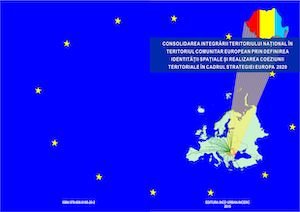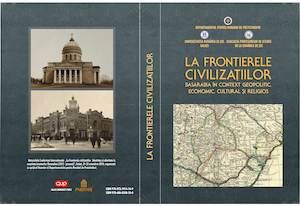
Consideraţii ecologice şi geografice privind potenţialul eco-energetic al României
The chapter presents several ecological and geographical considerations on and geospatial analyses of the eco-energy potential of Romania.
More...We kindly inform you that, as long as the subject affiliation of our 300.000+ articles is in progress, you might get unsufficient or no results on your third level or second level search. In this case, please broaden your search criteria.

The chapter presents several ecological and geographical considerations on and geospatial analyses of the eco-energy potential of Romania.
More...
Un sumar bilanţ al activităţii portului Bugaz pe parcursul celor aproape opt ani, între redeschiderea traficului şi cedarea ocupantului sovietic, relevă rezultate pozitive pe mai multe paliere. Populaţia locală şi cea din hinterlandul portului, care a cuprins o regiune de 100 km din sudul Basarabiei, a beneficiat de un debuşeu pentru exportul produselor cerealiere, cu preţuri avantajoase şi stimulative. Navigaţia între Marea Neagră şi limanul Nistrului s-a îmbunătăţit ca urmare a amplasării balizelor şi instalaţiilor de acostare a navelor. De aceste facilităţi au beneficiat nu numai navele care veneau la încărcat, ci şi pescarii din zonă. Numărul locurilor de muncă, stabile şi temporare, a crescut. Portul Bugaz a provocat o mişcare economică şi comercială în sudul Basarabiei cu efecte în îmbunătăţirea transporturilor pe apă cu porturile Constanţa şi Sulina, de unde cerealele luau drumul spre pieţele din Orientul Mijlociu şi Occident. La Bugaz s-a derulat o activitate „determinată şi condusă în spirit naţional românesc”, într-o zonă cu o populaţie eterogenă şi cu o utilizare pentru comunicare „din ce în ce mai întinsă a limbii româneşti” . Indubitabil, portul Bugaz a contribuit la consolidarea procesului conexării Basarabiei la economia unitară a României.
More...
In recent decades, Iraqi historical cities have witnessed substantial urban and social changes that have turned them into unattractive places for living and investment, and where development potential has been ignored. The weakness of strategic plans regarding the consideration of the present urban development strategies has led to the random growth of the city, the distortion of cultural heritage sites and the quality of life in cities, generating social and environmental problems. That is why there is a need for the foundation of a territorial development strategy of Iraq and the studied area - the Diyala region and the city of Baquba, which is in accordance with the objectives of sustainable development at the world level and with modern urban regeneration approaches, which implies the improvement of the historical identity and cultural. The outcome of the development strategy of Dyala region and Baquba city must reflect the objectives of sustainable development and have a clear vision and strategic objectives in the short and medium term.
More...
This presentation provides evidence of the influential role of urban planning in directing human activity, which, if not adequately studied, may lead to instability in identity and social integration, and the role of urban planning in transforming cohesive groups into dispersed social groups, distinguished by class, creed, or wealth, and their direct role in fueling hatred futurism is a concrete prelude to conflict. Also, it presents some international examples applied in this field.
More...
The concept of smart growth appeared in the mid-1990s in the United States of America. The notion of a smart city emerged later, referring to how a city can favor the use of information technology. In Romania, the number of smart growth initiatives has continuously increased in recent years. Currently, there are such projects in both large and small cities. This research aims to analyze the implementation stage of smart growth initiatives in three Danube cities: Galati, Brăila and Tulcea.
More...
The paper explores the link between the architecture and the natural landscape of thermal baths, which were built in Hungary (Budapest) and Romania (Băile Herculane) during the early 20th century. Through a combination of various methods of inquiry, such as field trips and literature documentation, this research was able to develop a deeper understanding of the subject. The actual conditions of built heritage differs in the two countries, but are quite similar in the hazards it is prone to. With the aim of raising the public awareness of the problems facing the natural and urban landscape, this paper presents a brief description of the investigation of the thermal baths changes over time.
More...
The Russia-Ukraine conflict has considerably slowed the construction sector's recovery from the global COVID-19 lockdown. Because of rising debt levels, the short-term picture is uncertain. Both public and private sector initiatives will face challenges, with government funds devoted to efforts to address acute socioeconomic crises, and high building material prices rendering private sector projects unviable. Global climate change and global warming are problems that affect everyone, every country, and everything alive. It is a challenge felt in every sector, from agriculture to water supply and sustainable land management, from unemployment to economic stability, from democracy to security, and especially in the health sectorThe current decade has been defined by the fight against inequality, epidemics, and climate change. Technological advancements, such as digitalization and automation, will continue to have an impact on all parts of our life.
More...
Homs City was heavily damaged during the Syrian War, and thousands of people were killed. However, the people of Homs City have shown remarkable resilience in rebuilding their city. In recent years, Homs City has begun to recover, and many people are returning to their homes.
More...
From the emergence of the concept of sustainable development to the present day, this model of development has been a global policy with economic, social and environmental implications, of major importance for our common good. Achieving sustainable development goals requires a holistic, long-term approach. The realization of the sustainable development vision and the monitoring of progress are based on indicators of achievement that need to be linked to specific actions over a time horizon. Identifying the right indicators and interpreting them is crucial. This paper provides an overview of the challenge of measuring indicators for monitoring progress on sustainable development and is a starting point for future in-depth analysis of the indicators associated with the 17 SDGs and the criteria for their selection.
More...
The notion of smart cities has emerged as an essential solution for tackling the significant challenges facing contemporary society, including rapid urbanization, climate change and globalization. Smart cities harness state-of-the-art technologies like the Internet of Things (IoT), Big Data, Artificial Intelligence (AI) and Machine Learning (ML) to enhance various aspects of urban life, spanning from living conditions and work environments to information accessibility, social interactions and environmental sustainability. This technological integration offers numerous benefits, accelerating infrastructure development and improving residents' quality of life. Standardization and the incorporation of international standards, such as ISO 37120, ISO 37122 and ISO 37123 play a crucial role in assessing city performance. Romania's adoption of these standards represents a significant step towards evaluating and improving its cities. However, for efficacious implementation, it is imperative to develop implementation guidelines and provide support and training to local authorities. A comprehensive list of 95 performance indicators, categorized into six domains, can provide cities with essential tools for assessing and monitoring their progress towards becoming smart cities and promoting sustainable development. Customizing these indicators to match the unique characteristics of each city and fostering close collaboration with local communities, organizations and experts are crucial aspects for shaping and overseeing strategic objectives that positively influence the quality of life and sustainable urban development. This personalized approach is vital for the successful realization of smart cities.
More...
Biodiversity loss needs urgent, deep measures and solutions towards sustainability on the scale of the entire society, allowing political, social, economic and technological changes. These solutions involves difficult choices of decision factors in accordance with a new paradigm of governance. It is the role of spatial planning and environment policies to take into account the change in the governance of biodiversity through multiple, simultaneous forms of governance that ensure solutions with a sustainable impact, which are understood and in the interest of all residents. The aim of this research is to assess new findings in the governance of green infrastructure, on the basis of scientific literature of the last years. The analysis focused on the solutions and requirements to transform the present environmental governance so as to stop biodiversity loss and to find key actors necessary in the urban future. The results show that so far, biodiversity governance at local level has had limited effectiveness. New, specific types of urban governance addressing green infrastructure operate more and more often, such as the governance of nature-based solutions. The key actors and mechanisms associated with financing urban green infrastructure are local authorities, citizens and investors, and the financing mechanisms depend on the type and size of the green infrastructure that will be planned.
More...
This article aims to explore sustainable development pathways in the housing sector of post-communist countries from the former Eastern Bloc, in the context of the ongoing growth of major urban centers, contemporary changes and socio-economic transformations within cities. To establish the limits of this brief research, we will examine sustainable development through social, economic, political and demographic aspects. Additionally, to enhance our understanding of sustainable housing development, we will apply a multidisciplinary approach to two case studies: Romania and France. By adopting this multidisciplinary perspective, we will compile and analyze the key events along a timeline that underlie major paradigm shifts in each researched domain. Comparing these events in terms of temporality and intensity will provide insights into the parameters under which sustainable housing developments should evolve.
More...
The study explores the strategic integration of green-blue infrastructure (GBI) in the Râmnicu Vâlcea Metropolitan Area (MA-VL), Romania. The research addresses environmental, mobility, and quality-of-life concerns while examining local urban strategies and their approach to GBI implementation, identifying gaps and opportunities for sustainable development. Despite different levels of engagement with GBI concepts, most local plans incorporate elements like green spaces, water management, and sustainable transport. The study proposes a unified GBI framework for the area, emphasising stakeholder engagement, pilot projects, and community involvement to enhance environmental resilience and quality of life.
More...